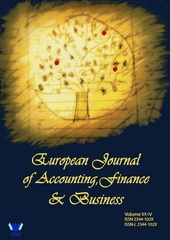|

ISSN: 2344 - 102X
ISSN-L: 2344 - 102X
Our journal is currently indexed in the following databases:
|
| |
Article from Volume 8, Number 3, Year 2020| BANKRUPTCY RISK - CONCEPTS AND APPROACHES IN THE ECONOMIC LITERATURE | 
Download | | Author(s): Veronica Grosu, Ancuta - Anisia Chelba | | DOI: 104316/EJAFB.2020.8314 | | Abstract: In a competitive economy, the development of a business is closely linked to the occurrence and manifestation of any type of risk. The risk consists in the occurrence of a future event, probably, but uncertain which results in a damage or loss manifested in the form of a company's inability to meet its objectives. The main objective of this article is to provide a realistic and useful introduction to addressing the concept and definitions of bankruptcy risk in the literature. This topic was chosen because we believe that only by applying a bankruptcy risk assessment model will economic entities know the real financial situation they face at a given time, thus having the opportunity to rethink the decision-making process. | | Keywords: Bankruptcty Risk, Prediction Model, Financial Difficulty | References:
1. Altman, E. I. (1968). Financial Ratios, Discriminant Analysis And The Prediction Of Corporate Bankruptcy. The Journal Of Finance, 23(4), 589-609.
2. Altman, E., Hartzell, J. And Peck, M. (1995). Emerging Markets Corporate Bonds: A Scoring System, (New York, Salomon Brothers Inc), Reprinted In The Future Of Emerging Market Flows, Edited By Levich, R. Mei, J.P. 1997, Kluwer, Holland.
3. Altman, E.I. (1993). Corporate Financial Distress And Bankruptcy, Second Edition, John Wiley & Sons, New York.
4. Beaver, W. H. (1966). Financial Ratios As Predictors Of Failure. Journal Of Accounting Research, 4, 71-111.
5. Biddle, G. C., Ma, M. L., & Song, F. M. (2020). Accounting Conservatism And Bankruptcy Risk. Journal Of Accounting, Auditing And Finance, Forthcoming. Retrieved August 3, 2020 From Https://papers.ssrn.com/sol3/Papers.cfm?abstract_id=1621272
6. Boettcher, J., Cavanagh, G., & Xu, M. (2014). Ethical Issues That Arise In Bankruptcy. Business And Society Review, 119(4), 473-496.
7. Chelba, A. A. & Anisie, L. (2020). Accounting Practices Regarding The Means Of Operation With Cash Flows, European Journal Of Accounting, Finance & Business, 13(23). Retrieved August 3, 2020 From Http://accountingmanagement.ro/index.php?pag=showcontent&issue=23&year=2020
8. Chou, C. H., Hsieh, S. C., & Qiu, C. J. (2017). Hybrid Genetic Algorithm And Fuzzy Clustering For Bankruptcy Prediction. Applied Soft Computing, 56, 298-316. Https://doi.org/10.1016/j.asoc.2017.03.014
9. Dichev, I. D. (1998). Is The Risk Of Bankruptcy A Systematic Risk? The Journal Of Finance, 53(3), 1131–1147. Doi: 10.1111/0022- 1082.00046
10. Dumitrescu, G. (2010). Studii De Cercetare Cu Privire La Riscul De Faliment: Modele ?i Metode De Previzionare, Revista Român? De Statistic?, 4.
11. Holt, G. (2009). Riscul De Faliment - Punct Central în Diagnosticul Financiar– Contabil. Annals Of “Constantin Brâncu?i” University Of Târgu Jiu, 3, 321-332.
12. Horváthová, J., & Mokrišová, M. (2018). Risk Of Bankruptcy, Its Determinants And Models. Risks, 6(4), 117, Https://doi.org/10.3390/risks6040117
13. Http://apps.webofknowledge.com
14. Kliestik, T., Misankova, M., Valaskova, K., & Svabova, L. (2018). Bankruptcy Prevention: New Effort To Reflect On Legal And Social Changes. Science And Engineering Ethics, 24(2), 791-803.
15. Kordestani, G., Bakhtiari, M., & Biglari, V. (2011). Ability Of Combinations Of Cash Flow Components To Predict Financial Distress. Business: Theory And Practice, 12(3), 277-285. Doi: 10.3846/btp.2011.28
16. Korol, T. (2019). Dynamic Bankruptcy Prediction Models For European Enterprises. Journal Of Risk And Financial Management, 12(4), 185, Https://doi.org/10.3390/jrfm12040185
17. Lu, Y. C., & Chang, S. L. (2009). Corporate Governance And Quality Of Financial Information On The Prediction Power Of Financial Distress Of Listed Companies In Taiwan. International Research Journal Of Finance And Economics, 32(1), 121-139.
18. MacCarthy, J. (2017). Using Altman Z-score And Beneish M-score Models To Detect Financial Fraud And Corporate Failure: A Case Study Of Enron Corporation. International Journal Of Finance And Accounting, 6(6), 159-166, Doi: 10.5923/j.ijfa.20170606.01
19. Mai, F., Tian, S., Lee, C., & Ma, L. (2019). Deep Learning Models For Bankruptcy Prediction Using Textual Disclosures. European Journal Of Operational Research, 274(2), 743-758, Https://doi.org/10.1016/j.ejor.2018.10.02
20. Nguyen, S. L., Pham, C. D., & Nguyen, A. H. (2020). Impact Of Corporate Social Responsibility Disclosures On Bankruptcy Risk Of Vietnamese Firms. The Journal Of Asian Finance, Economics, And Business, 7(5), 81-90, Doi:10.13106/jafeb.2020.vol7.no5.081
21. Ohlson, J.A. (1980). Financial Ratios And The Probabilistic Prediction Of Bankruptcy, Journal Of Accounting Research, 18(1), 109-131.
22. Onakoya, A. B., & Ayooluwa, E. O. (2017). Bankruptcy And Insolvency: An Exploration Of Relevant Theories. International Journal Of Economics And Financial Issues, 7(3), 706-712.
23. Telipenko, E. V., Zakharova, A. A., & Sopova, S. P. (2015, September). Forecasting Risk Of Bankruptcy For Machine-building Plants. In IOP Conference Series: Materials Science And Engineering, 91(1), P. 012066), Doi:10.1088/1757-899X/91/1/012066
24. Teodorescu, C. D. (2017). Bankruptcy Risk–classical Models Versus Romanian Models. Scientific Bulletin" Mircea Cel Batran" Naval Academy, 20(1), 126-131. Doi: 10.21279/1454-864X-17-I1-022
25. Valencia, C., Cabrales, S., Garcia, L., Ramirez, J., & Calderona, D. (2019). Generalized Additive Model With Embedded Variable Selection For Bankruptcy Prediction: Prediction Versus Interpretation. Cogent Economics & Finance, 7(1), 1597956. Https://doi.org/10.1080/23322039.2019.1597956
26. Venkataramana, N., Azash, S., & Ramakrishnaiah, K. (2012). Financial Performance And Predicting The Risk Of Bankruptcy: A Case Of Selected Cement Companies RCMSS/IJPAMR/12004
|
| | Back to journal ... |
|
|
| |
|
|
|

